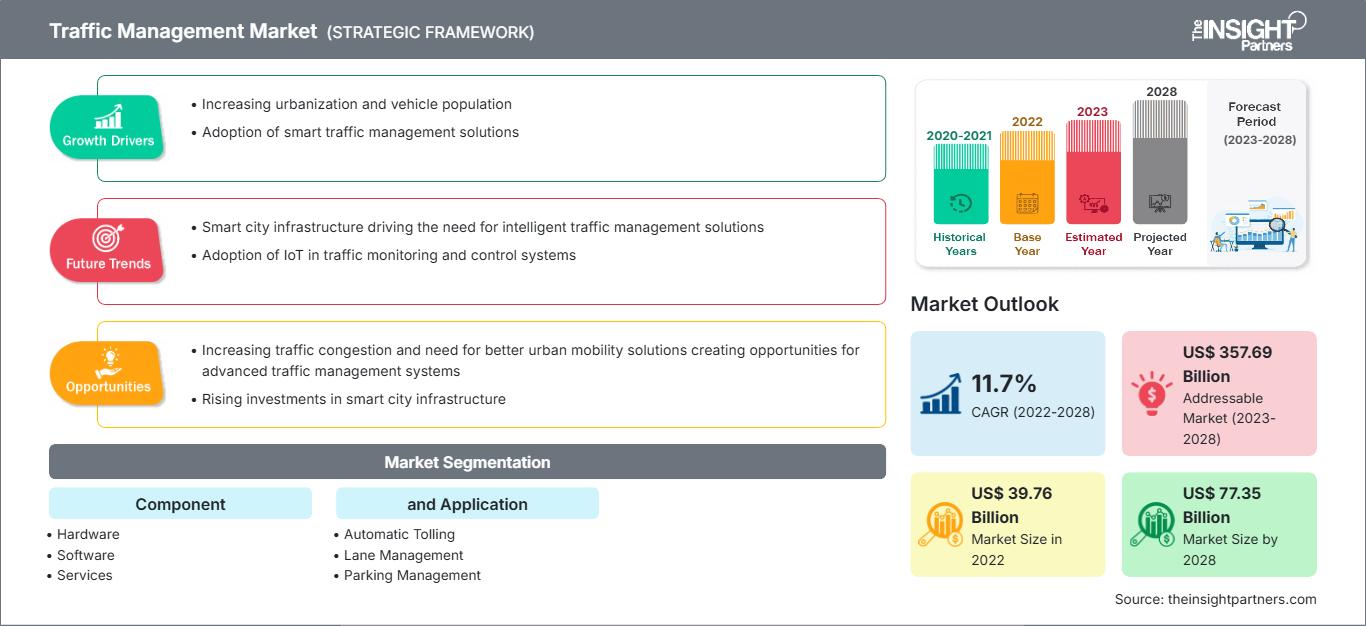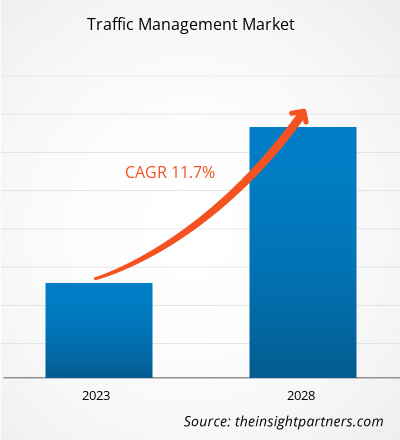预计到 2028 年,交通管理市场规模将从 2022 年的 397.5674 亿美元增至 773.4644 亿美元;预计 2022 年至 2028 年的复合年增长率为 11.7%。
多年来,大多数国家都经历了剧烈的城市化,导致道路网络复杂,交通拥堵严重。城市人口的增加,加上私家车拥有量的增加,导致道路上的车辆数量不断增加。印度孟买的人口从 2011 年的 1850 万增加到 2020 年的 2040 万,而私家车数量在此期间几乎翻了一番。由于这些因素以及为了补救这些因素,预计交通管理市场将会增长。此外,Uber、Grab、Ola 和 Lyft 等出租车聚合商提供的叫车服务也在快速增长。此类服务已经取代了公共交通系统,导致道路上的车辆激增。这些因素迫使政府当局向交通管理市场参与者寻求有效的解决方案。强大的交通管理系统可以有效缓解交通拥堵,该系统包括软件、传感器、摄像头和显示板。这些系统可以安装在现有道路上,无需改造基础设施。同样,车道管理系统可以通过打开或关闭车道来有效地管理交通流量,具体取决于每个时间点的交通流量。考虑到交通管理系统带来的优势,快速的城市化速度预计将大幅提升交通管理市场规模。
COVID-19 疫情对交通管理市场增长的影响
COVID-19 疫情扰乱了汽车、制造、能源和电力、航空航天等垂直行业。 2020年,国防和建筑行业经历了前所未有的挑战。新冠疫情感染人数的持续增长迫使美国等国政府在2020年前三个季度实施了严格的封锁措施,导致各国交通运输量大幅下滑。贸易禁令、旅行限制和人员限制等防疫措施影响了各类企业的制造、供应和销售活动,包括提供交通管理硬件、软件和服务的公司。由于工厂暂时停工和产量下降,制造业遭受了严重损失,这也阻碍了交通管理硬件系统的生产。在美国,联邦政府和州政府将更多精力放在应对疫情上,导致交通管理硬件和软件的安装暂时搁置。欧洲交通管理行业受到重创,基础设施项目支出减少约20%,导致多个智慧城市和智慧道路项目延期或中止。半导体价格上涨和供应链中断进一步加剧了形势。不过,交通管理市场在 2020 年第四季度开始出现正增长。
自定义此报告以满足您的要求
您将免费获得任何报告的定制,包括本报告的部分内容,或国家级分析、Excel 数据包,以及为初创企业和大学提供超值优惠和折扣
交通管理市场: 战略洞察

- 获取本报告的主要市场趋势。这个免费样本将包括数据分析,从市场趋势到估计和预测。
您将免费获得任何报告的定制,包括本报告的部分内容,或国家级分析、Excel 数据包,以及为初创企业和大学提供超值优惠和折扣
交通管理市场: 战略洞察

- 获取本报告的主要市场趋势。这个免费样本将包括数据分析,从市场趋势到估计和预测。
市场洞察 - 交通管理市场
全球正见证互联设备的蓬勃发展,许多国家正在投资建设智慧城市。智慧城市是技术先进的城市区域,采用各种传感器和电子方法收集数据并利用这些数据改善当地环境。智慧城市旨在制定长期的交通管理计划,通过优化交通和物流并减少交通拥堵来管理交通。因此,除了智慧城市之外,各国也在投资建设智慧道路,以提供更安全的车辆通勤。在智慧道路上,不同类型的传感器和硬件收集用于监控交通状况的多变量数据。这些数据还可以与道路上行驶的车辆共享,使驾驶员和通勤者能够做出明智的决策。因此,智慧城市和智慧道路的日益普及有望扩大交通管理市场的规模。
基于组件的洞察
交通管理市场根据组件、应用和地域进行细分。按组件划分,市场分为硬件、软件和服务。硬件市场进一步细分为摄像头、显示板和传感器;此外,软件市场分为云端和本地。不同的政府机构一直在投资升级其交通管理硬件。日益增长的城市化和不断增加的汽车拥有量给城市道路带来了负担。因此,当局依靠现代摄像头更好地维护交通流量并确保安全。自动车牌识别 (ANPR) 摄像头越来越多地用于识别违规者或在事故调查期间定位车辆。它们通常与激光传感器配对,用于确定车速。
按应用划分,交通管理市场细分为自动收费、车道管理、停车管理、监控、交通信号管理等。根据地域划分,市场主要细分为北美、欧洲、亚太地区 (APAC)、中东和非洲 (MEA) 和南美 (SAM)。IBM 公司;思科系统公司;西门子股份公司;杭州海康威视数字技术股份有限公司、大华技术股份有限公司是交通管理市场的主要参与者。
交通管理市场区域洞察
The Insight Partners 的分析师已详尽阐述了预测期内影响交通管理市场的区域趋势和因素。本节还讨论了北美、欧洲、亚太地区、中东和非洲以及南美和中美洲的交通管理市场细分和地域分布。
交通管理市场报告范围
| 报告属性 | 细节 |
|---|---|
| 市场规模 2022 | US$ 39.76 Billion |
| 市场规模 2028 | US$ 77.35 Billion |
| 全球复合年增长率 (2022 - 2028) | 11.7% |
| 历史数据 | 2020-2021 |
| 预测期 | 2023-2028 |
| 涵盖的领域 |
By 组件
|
| 覆盖地区和国家 | 北美
|
| 市场领导者和主要公司简介 |
|
交通管理市场参与者密度:了解其对业务动态的影响
交通管理市场正在快速增长,这得益于终端用户需求的不断增长,而这些需求的驱动因素包括消费者偏好的不断变化、技术进步以及对产品优势的认知度不断提高。随着需求的增长,企业正在扩展其产品线,不断创新以满足消费者需求,并利用新兴趋势,从而进一步推动市场增长。

- 获取 交通管理市场 主要参与者概述
交通管理市场参与者主要专注于开发先进高效的产品。
- 2021年,大华股份宣布推出一套全面的智慧交通管理解决方案,该解决方案将视频监控与人工智能、车牌识别、图像融合、增强现实和其他尖端技术相结合,以满足现代交通执法部门的多样化需求。
- 2021年,专注于摄像头的物联网解决方案提供商海康威视推出了其最新的交通产品——全能型智能交通系统 (ITS) 摄像头,旨在提高道路安全和交通流量。这款摄像头集多种功能于一身,包括速度检测、交通违规检测、自动车牌识别和车辆属性分析。
- 历史分析(2 年)、基准年、预测(7 年)及复合年增长率
- PEST和SWOT分析
- 市场规模、价值/数量 - 全球、区域、国家
- 行业和竞争格局
- Excel 数据集
近期报告
相关报告
客户评价
购买理由
- 明智的决策
- 了解市场动态
- 竞争分析
- 客户洞察
- 市场预测
- 风险规避
- 战略规划
- 投资论证
- 识别新兴市场
- 优化营销策略
- 提升运营效率
- 顺应监管趋势




















 获取免费样品 - 交通管理市场
获取免费样品 - 交通管理市场